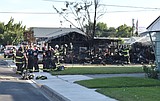Royal parents learn to identify drug risk factors
JOEL MARTIN | Hagadone News Network | UPDATED 2 years, 2 months AGO
Joel Martin has been with the Columbia Basin Herald for more than 25 years in a variety of roles and is the most-tenured employee in the building. Martin is a married father of eight and enjoys spending time with his children and his wife, Christina. He is passionate about the paper’s mission of informing the people of the Columbia Basin because he knows it is important to record the history of the communities the publication serves. | June 14, 2023 1:30 AM
ROYAL CITY — Between 20 and 30 people gathered at Royal Intermediate School June 8 for Healthy Youth, Healthy Families. The bilingual event, sponsored by Educational Service District 105, among other organizations, was designed to help families identify signs of substance abuse in youth.
“My demographic right now is particularly 10- to 13-year-olds,” said Ariana Martinez, a student assistance professional for ESD 105 attached to the Royal School District. “They're the ones kind of keeping up with the Tik Tok trends, whether that's using tampons to get drunk, putting them in alcohol, or challenges (to see) who can show up the highest at school and not get caught.”
Part of the training involved a replica of a teenager’s bedroom, to illustrate the ingenious ways kids might hide or disguise drugs or paraphernalia, and to help parents see through the subterfuge.
“We're training parents to recognize different devices, different risk factors, different signs of danger when it comes to a teenage bedroom,” said Brisa Sanchez, a community prevention specialist for ESD 105, also based in Royal City. “So if they're seeing aluminum (foil), and cotton buds in random places, balloons, wires, coils, things that aren’t usually things you need for school. There's vaping devices that could look like a like a spray deodorant, they could look like a bottle of perfume. The whole idea is we're training parents so that it will be easier for them to recognize vaping devices.”
Along with the identification training, attendees were given information about fentanyl, a dangerously powerful opioid that’s become prevalent recently, and learned how to recognize the signs of an opioid overdose and administer naloxone, or Narcan, a nasal spray that can reverse an overdose.
“There's instances where kids are seeing someone who's looking like they're having signs of overdose, and instead of helping, they're leaving. So we're hoping to empower them so that they have the knowledge they need to help.
Attendees were invited to take a free Narcan kit, offered by the Recovery Navigator Program, which had a table at the event. The Recovery Navigator Program works with law enforcement to help people who run afoul of the law because of substance abuse, but also assists anybody struggling with addiction, said Nick Baker, one of the RNP staff manning the table. That assistance can be anything from getting into a rehab program to simply getting an ID, which Baker said is often a first stepping stone to recovery.
“We are addicts in long-term recovery,” Baker said. “So we have the lived experience that people might still be going through. We've been through all that. We're able to walk with them.”
Sanchez agreed and said it’s a matter of standing beside those in recovery and being situationally aware.
“(We have to) practice and practice and practice having these hard conversations: talking about feelings, talking about expectations, talking about if this happens, what are you going to do then?” Sanchez said. “Insist that they not (ever take) any pills that have not been prescribed by the doctor, coming out of the prescription package. Pills purchased on social media are not safe. That's a fact. We need to tell them; we need to have a conversation with them multiple times. It needs to be repeated.”
Joel Martin can be reached via email at jmartin@columbiabasinherald.com.
ARTICLES BY JOEL MARTIN

4-car injury collision near Quincy Valley Rest Area
EPHRATA — A three- to four-vehicle collision has been reported in the vicinity of Road 10 Northwest and state Route 28 south of Ephrata, according to MACC dispatch. At least one of the vehicles is a semi and injuries have been reported as of 3:30 p.m. Readers may wish to avoid the area. This report will be updated as information becomes available.

Quincy house catches fire Sunday morning, no injuries
QUINCY – Nobody was hurt when a residence in Quincy caught fire Sunday morning.

50-acre fire quickly contained near Ephrata
EPHRATA - A fire broke out Saturday morning between Moses Lake and Ephrata but was quickly knocked down, according to Grant County Fire District 5 Battalion Commander Travis Svilar.

